 W
WThis is a list of cooking vessels. A cooking vessel is a type of cookware or bakeware designed for cooking, baking, roasting, boiling or steaming. Cooking vessels are manufactured using materials such as steel, cast iron, aluminum, clay and various other ceramics. Some cooking vessels, such as ceramic ones, absorb and retain heat after cooking has finished.
 W
WA bain-marie, a type of heated bath, is a piece of equipment used in science, industry, and cooking to heat materials gently or to keep materials warm over a period of time. A bain-marie is also used to melt ingredients for cooking.
 W
WA beanpot is a deep, wide-bellied, short-necked vessel used to cook bean-based dishes. Beanpots are typically made of ceramic, though some are made of other materials, such as cast iron. The relatively narrow mouth of the beanpot minimizes evaporation and heat loss, while its deep, wide, thick-walled body facilitates long, slow cooking times.
 W
WA caquelon is a cooking vessel of stoneware, ceramic, enamelled cast iron, or porcelain for the preparation of fondue, also called a fondue pot.
 W
WA casserole is a variety of a large, deep pan or bowl used for cooking a variety of dishes in the oven; it is also a category of foods cooked in such a vessel. To distinguish the two uses, the pan can be called a "casserole dish" or "casserole pan", whereas the food is simply "a casserole". The same pan is often used both for cooking and for serving.
 W
WA cassole is a conical earthenware container, glazed inside. The bowl is made from red clay and is noted for its capacity to retain heat.
 W
WHeavy-duty cookware made of cast iron is valued for its heat retention, durability, ability to be used at very high temperatures, and non-stick cooking when properly seasoned. Seasoning is also used to protect bare cast iron from rust. Types of cast iron cookware include frying pans, dutch ovens, griddles, waffle irons, flattop grills, panini presses, crepe makers, deep fryers, tetsubin, woks, potjies, and karahi.
 W
WA cataplana is an item of cookware used to prepare Portuguese seafood dishes, popular in the country's Algarve region. According to The Oxford Companion to Food, the most famous dish made in a cataplana is amêijoas na cataplana.
 W
WA cauldron is a large pot (kettle) for cooking or boiling over an open fire, with a lid and frequently with an arc-shaped hanger. In other words, a large kettle.
 W
WA cezve is a small long-handled pot with a pouring lip designed specifically to make Turkish coffee. It is traditionally made of brass or copper, occasionally also silver or gold. In more recent times cezveler are also made from stainless steel, aluminium, or ceramics.
 W
WA chafing dish is a metal cooking or serving pan on a stand with an alcohol burner holding chafing fuel below it. It is used for cooking at table, notably in Gueridon service, or as a food warmer for keeping dishes at a buffet warm.
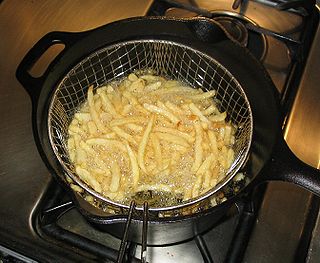 W
WA chip pan is a deep-sided cooking pan used for deep-frying. Chip pans are named for their traditional use in frying chips.
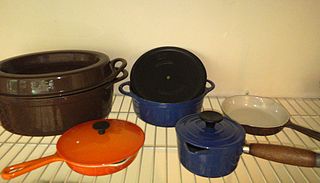 W
WCousances was a French cookware manufacturer, known for enameled cast iron pans. The Cousances foundry in northeastern France began making cast iron pans in 1553; four centuries later, by then an international company, it was acquired by Le Creuset in 1957. Cookware under the Cousances brand continued to be manufactured by Le Creuset into the early 1980s.
 W
WA couscoussier is a traditional double-chambered food steamer used in Berber cuisine to cook couscous.
 W
WA crock is a pottery container sometimes used for food and water, synonymous with the word pot, and sometimes used for chemicals. Derivative terms include crockery and crock-pot.
 W
WA dallah is a traditional Arabic coffee pot used for centuries to brew and serve Qahwa (gahwa), an Arabic coffee or Gulf coffee made through a multi-step ritual, and Khaleeji, a spicy, bitter coffee traditionally served during feasts like Eid al-Fitr.
 W
WDing (鼎) are prehistoric and ancient Chinese cauldrons, standing upon legs with a lid and two facing handles. They are one of the most important shapes used in Chinese ritual bronzes. They were made in two shapes: round vessels with three legs and rectangular ones with four, the latter often called fangding. They were used for cooking, storage, and ritual offerings to the gods or to ancestors. The earliest recovered examples are pre-Shang ceramic ding at the Erlitou site but they are better known from the Bronze Age, particularly after the Zhou deemphasized the ritual use of wine practiced by the Shang kings. Under the Zhou, the ding and the privilege to perform the associated rituals became symbols of authority. The number of permitted ding varied according to one's rank in the Chinese nobility: the Nine Ding of the Zhou kings were a symbol of their rule over all China but were lost by the first emperor, Shi Huangdi in the late 3rd century BCE. Subsequently, imperial authority was represented by the Heirloom Seal of the Realm, carved out of the sacred Heshibi; it was lost at some point during the Five Dynasties after the collapse of the Tang.
 W
WA dolsot or gopdolsot is a small-sized piece of cookware or serveware made of agalmatolite, suitable for one to two servings of bap. In Korean cuisine, various hot rice dishes such as bibimbap or gulbap as well as plain white rice can be prepared and served in dolsot. As a dolsot does not cool off as soon as removed from the stove, rice continues to cook and arrives at the table still sizzling.
 W
WA Dutch oven is a thick-walled cooking pot with a tight-fitting lid. Dutch ovens are usually made of seasoned cast iron; however, some Dutch ovens are instead made of cast aluminium, or ceramic. Some metal varieties are enameled rather than being seasoned, and these are sometimes called French ovens. Dutch ovens have been used as cooking vessels for hundreds of years. They are called casserole dishes in English-speaking countries other than the United States, and cocottes in French. They are similar to both the Japanese tetsunabe and the sač, a traditional Balkan cast-iron oven, and are related to the South African potjiekos, the Australian Bedourie oven and Spanish cazuela.
 W
WEarthenware is glazed or unglazed nonvitreous pottery that has normally been fired below 1,200 °C (2,190 °F). Basic earthenware, often called terracotta, absorbs liquids such as water. However, earthenware can be made impervious to liquids by coating it with a ceramic glaze, which the great majority of modern domestic earthenware has. The main other important types of pottery are porcelain, bone china, and stoneware, all fired at high enough temperatures to vitrify.
 W
WA fermentation crock, also known as a gärtopf crock or Harsch crock, is a crock for fermentation. It has a gutter in the rim which is then filled with water so that when the top is put on an airlock is created, which prevents the food within from spoiling due to the development of surface molds. Ceramic weights may also be used to keep the fermenting food inside submerged.
 W
WA fire basket is an iron basket in which wood can be burned to make a bonfire.
 W
WA fish kettle is a kind of large, oval-shaped kettle used for cooking whole fish. Owing to their necessarily unwieldy size, fish kettles usually have racks and handles, and notably tight-fitting lids.
 W
WA food steamer or steam cooker is a small kitchen appliance used to cook or prepare various foods with steam heat by means of holding the food in a closed vessel reducing steam escape. This manner of cooking is called steaming.
 W
WA food warmer is typically a table-top device used to maintain the serving temperature of prepared food. It is used both in homes and restaurants.
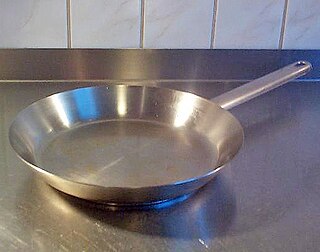 W
WA frying pan, frypan, or skillet is a flat-bottomed pan used for frying, searing, and browning foods. It is typically 20 to 30 cm in diameter with relatively low sides that flare outwards, a long handle, and no lid. Larger pans may have a small grab handle opposite the main handle. A pan of similar dimensions, but with less flared, more vertical sides and often with a lid, is called a sauté pan. While a sauté pan can be used as a frying pan, it is designed for lower heat cooking methods, namely sautéing.
 W
WGamasot (가마솥), or simply sot (솥), is a big, heavy pot or cauldron used for Korean cooking.
 W
WGrab-Its are microwave-safe cookware easily identifiable by their tab handle. They were introduced by Corning Glass Works in 1977, under the Corning Ware brand and are now sold in a slightly different form by Corelle Brands. Grab-Its are notable as being among the first cookware specifically designed for microwave use - their design was recognized by the Smithsonian's Cooper-Hewitt, National Design Museum. Grab-Its strongly resemble porringers.
 W
WA handi is a cooking basin made from copper or clay (pot) originating in the Indian subcontinent. It is utilised primarily in north Indian, Pakistani and Bangladeshi cooking.
 W
WJebena is a traditional Ethiopian and Eritrean coffee pot made of pottery. It is also used in Sudan, and the coffee itself is called buna.
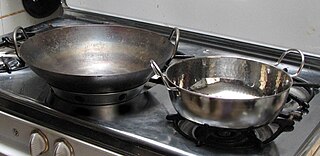 W
WA karahi is a type of thick, circular, and deep cooking pot that originated in the Indian subcontinent. It is used in Indian, Afghan, Pakistani, Bangladeshi, and Nepalese cuisines. Traditionally press-formed from mild steel sheet or made of wrought iron, a karahi resembles a wok with steeper sides. Today, they can be made of stainless steel, copper, and nonstick surfaces, both round and flat-bottomed, or of the traditional materials.
 W
WA kazan or qazan is a type of large cooking pot used throughout Central Asia, Azerbaijan, Turkey, and the Balkan Peninsula, roughly equivalent to a cauldron, boiler, or Dutch oven. They come in a variety of sizes, and are often measured by their capacity, such as "a 50-litre kazan". Usually their diameter is half a meter. Kazans are made of cast iron or in modern times aluminum and are used to cook a wide variety of foods, including plov (pilaf), sumalak, shorpa, kesme, and bawyrsaq, and as such are an important element in celebrations when food must be prepared for large numbers of guests.
 W
WA mold, or mould, is a container used in various techniques of food preparation to shape the finished dish. The term may also refer to a finished dish made in said container.
 W
WA multicooker is an electric kitchen appliance for automated cooking using a timer. A typical multicooker is able to boil, simmer, bake, fry, deep fry, grill roast, stew, steam and brown food.
 W
WOnggi is Korean earthenware extensively used as tableware and storage containers in Korea. It includes both unglazed earthenware, fired near 600 to 700°C, and pottery with a dark brown glaze fired at over 1100°C.
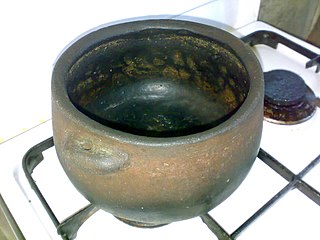 W
WA palayok is a clay pot used as the traditional food preparation container in the Philippines. Palayok is a Tagalog word; in other parts of the country, especially in the Visayas, it is called a kulon; smaller-sized pots are referred to as anglit. Neighboring Indonesia and Malaysia refer to such vessel as a periuk.
 W
WA pipkin is an earthenware cooking pot used for cooking over direct heat from coals or a wood fire. They were not held in direct flame which would crack the ceramic. It has a handle and many examples had three feet. Late medieval and post-medieval pipkins had a hollow handle into which a stick might be inserted for manipulation. Examples exist unglazed, fully glazed, and glazed only on the interior.
 W
WA porringer is a shallow bowl, between 4 and 6 inches in diameter, and 1½" to 3" deep; the form originated in the medieval period in Europe and was made in wood, ceramic, pewter and silver. They had flat, horizontal handles. Colonial porringers tended to have one handle, whereas European ones tended to have two handles on opposite sides, on which the owner's initials were sometimes engraved, and they occasionally came with a lid. Porringers resembled the smaller quaich, a Scottish drinking vessel.
 W
WIn South Africa, a potjiekos, literally translated "small-pot food", is a dish prepared outdoors. It is traditionally cooked in a round, cast iron, three-legged cauldron, the potjie, descended from the Dutch oven brought from the Netherlands to South Africa in the 17th century and found in the homes and villages of people throughout southern Africa. The pot is heated using small amounts of wood or charcoal or, if fuel is scarce, twisted grass or even dried animal dung. Small LPG gas cylinders with a cooker top designed specifically for the potjie is also widely used in households in South Africa.
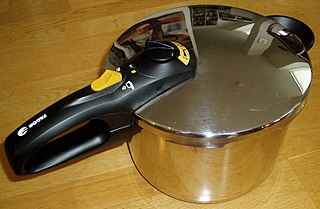 W
WPressure cooking is the process of cooking food under high pressure steam, employing water or a water-based cooking liquid, in a sealed vessel known as a pressure cooker. High pressure limits boiling, and permits cooking temperatures well above 100 °C (212 °F) to be reached. Pressures up to one atmosphere above STP are generally employed.
 W
WA ramekin is a small dish used for culinary purposes.
 W
WA rice cooker or rice steamer is an automated kitchen appliance designed to boil or steam rice. It consists of a heat source, a cooking bowl, and a thermostat. The thermostat measures the temperature of the cooking bowl and controls the heat. Complex, high-tech rice cookers may have sensors and other components, and may be multipurpose.
 W
WA roasting pan is a piece of cookware used for roasting meat in an oven, either with or without vegetables or other ingredients. A roasting pan may be used with a rack that sits inside the pan and lets the meat sit above the fat and juice drippings.
 W
WSinseollo or royal hot pot is an elaborate dish consisting of meatballs, small and round jeonyueo (전유어), mushrooms, and vegetables cooked in a rich broth in Korean royal court cuisine. The dish is a form of jeongol. It is served in a large bundt pan-shaped vessel with a hole in the center, in which hot embers are placed to keep the dish hot throughout the meal.
 W
WSiru (시루) is an earthenware steamer used to steam grain or grain flour dishes such as tteok.
 W
WA slow cooker, also known as a crock-pot, is a countertop electrical cooking appliance used to simmer at a lower temperature than other cooking methods, such as baking, boiling, and frying. This facilitates unattended cooking for many hours of dishes that would otherwise be boiled: pot roast, soups, stews and other dishes.
 W
WA springform pan is a type of bakeware that features sides that can be removed from the base. Springform refers to the construction style of this pan. The base and the sides are separate pieces that are held together when the base is aligned with a groove that rings the bottom of the walls. The pan is then secured by a latch on the exterior of the wall. This tightens the 'belt' that becomes the walls of the pan and secures the base into the groove at the base of the walls.
 W
WStock pot is a generic name for one of the most common types of cooking pot used worldwide. A stock pot is traditionally used to make stock or broth, which can be the basis for cooking more complex recipes. It is a wide pot with a flat bottom, straight sides, a wide opening to the full diameter of the pot, two handles on the sides, and a lid with a handle on top.
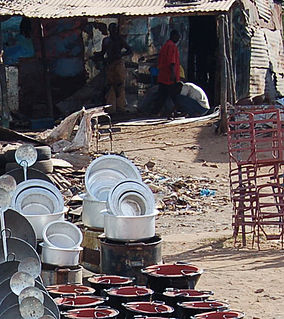 W
WA sufuria is a Swahili language word, adopted in the local African Great Lakes regional variety of English, for a flat based, deep sided, lipped and handleless cooking pot or container. It is ubiquitous in Kenya, Tanzania and other Great Lakes nations. A replacement for more traditional crockery containers, it's used in many Kenyan households for cooking, serving and storing food. Most sufuria are today made of aluminum, and produced and purchased locally in the informal sector. Sufuria were traditionally used to cook over open fire, charcoal brazier, or coals, and are purchased in a variety of sizes, with and without lids.
 W
WTangia is an urn-shaped terra cotta cooking vessel. It is also the name of the stew cooked in the pot. It is common in Marrakech, Morocco.
 W
WTapayan or tempayan are large wide-mouthed earthenware or stoneware jars found in various Austronesian cultures in island Southeast Asia. Their various functions include fermenting rice (tapai), fermenting vinegar or alcoholic beverages, storing food and water, cooking, and burial of the deceased.
 W
WA tava(h), tawa(h), tapa, saj, or saj tava is a flat or concave disc-shaped frying pan or griddle, usually made of cast iron, aluminum, or carbon steel. It may be enameled or given a non-stick surface. It is used in the cuisines of Central, West, and South Asia, and of the Caucasus, the Caribbean, and the Balkans. The large concave styles of tava, sometimes called a saj or sac tava, may be turned upside down for cooking a variety of flatbreads on the convex side. The concave side is used like a wok or frying pan.
 W
WA terrine is a glazed earthenware cooking dish with vertical sides and a tightly fitting lid, generally rectangular or oval. Modern versions are also made of enameled cast iron.
 W
WA thermal cooker, or a vacuum flask cooker, is a cooking device that uses thermal insulation to retain heat and cook food without the continuous use of fuel or other heat source. It is a modern implementation of a haybox, which uses hay or straw to insulate a cooking pot.
 W
WA tian is an earthenware vessel of Provence used both for cooking and serving. It is also the name of the dish prepared in it and baked in an oven.
 W
WA ttukbaegi (뚝배기) is a type of oji-gureut, which is an onggi coated with brown-tone ash glaze. The small, black to brown earthenware vessel is a cookware-cum-serveware used for various jjigae (stew), gukbap, or other boiled dishes in Korean cuisine. As a ttukbaegi retains heat and does not cool off as soon as removed from the stove, stews and soups in ttukbaegi usually arrive at the table at a bubbling boil.
 W
WUruli ( ഉരുളി) is a traditional cookware extensively used South Indian state of Kerala and few neighbouring places. It is also pronounced as Urli and commonly made of clay, copper and bronze. Urulis were used in home for cooking and in ayurvedha to make medicines. Now Urulis are used as a decorative bowl to float flowers which is a part of South Indian tradition.
 W
WA wok is a deep round-bottomed cooking pot that originated in China. It is common in China and similar pans are found in parts of East, South and Southeast Asia, as well as being popular in other parts of the world.
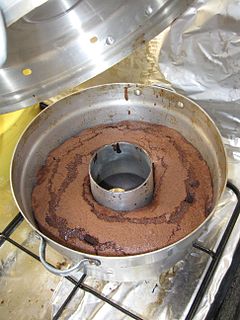 W
WWonder Pot is an Israeli invention for baking on top of a gas stove rather than in an oven. It consists of three parts: an aluminium pot shaped like a Bundt pan except smooth-sided rather than fluted, a hooded cover perforated with venting holes, and a thick, round, slightly domed metal disc with a center hole that is placed between the pot and the flame.